Activities on the farm
All cultivation and production is based on the principles of permaculture and regenerative agriculture, which have stricter operating criteria than today’s Debio-approved organic agriculture.
The premise of regenerative agriculture, with inspiration in the example of nature, is to create closed cycles, so that energy, nutrition, life and other elements are safeguarded in a holistic cycle. This means, for example, rebuilding the ecosystem in the soil so that the earth’s ability to store carbon increases, soil life improves, erosion is prevented and water is absorbed. Helene Bøhler, organizational coordinator for the Norwegian Permaculture Association, is helping us develop a plan for the farm, where soil, water, forest, wildlife and people support each other in balanced growth.
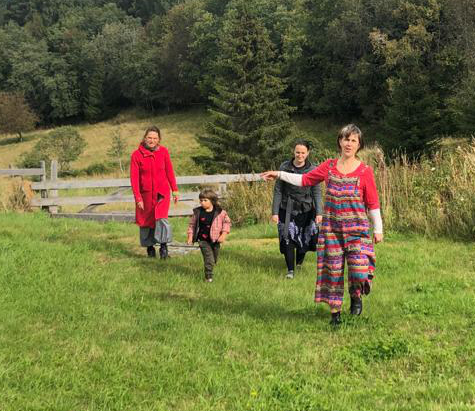
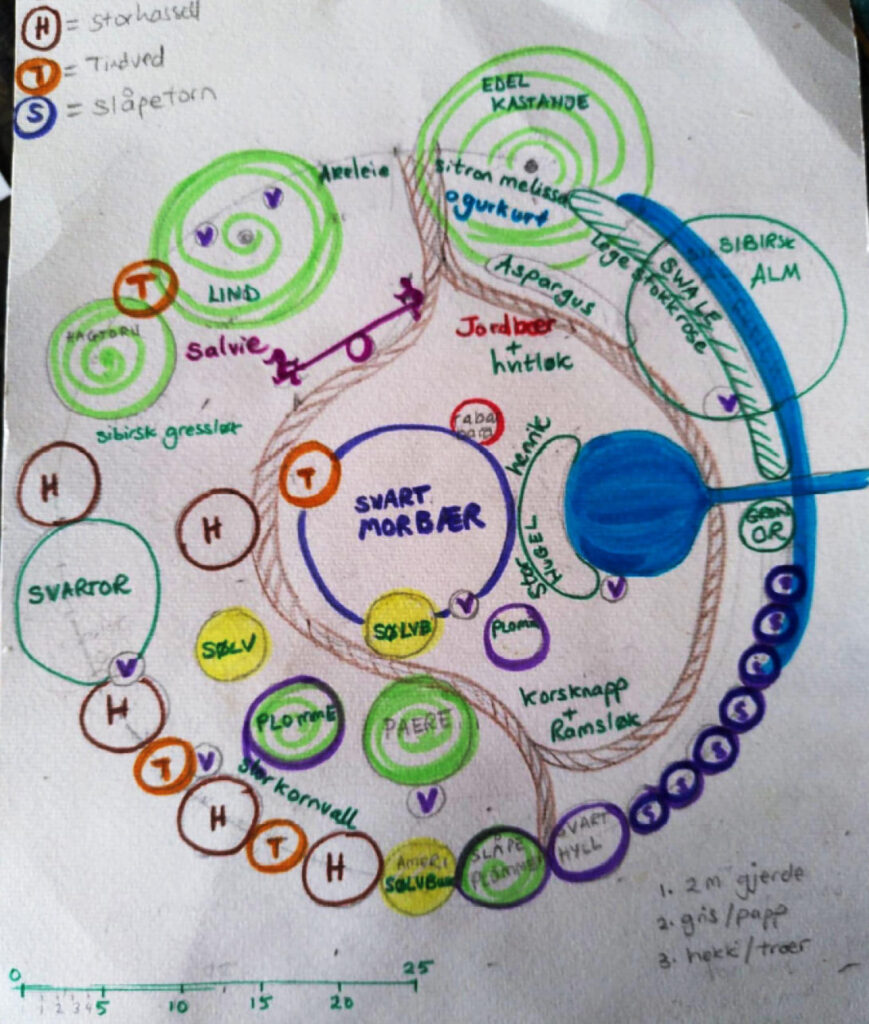
Georgiana is a bee-keeper but for the time being we are focussing on establishing optimal habitats for bumble bees – wild bees and insects. With lynx and pine martins in the forest we will need some careful preparation before inviting chickens to join us but we hope to do this in the not-too-distant future.
Georgiana has begun with the establishment of the forest garden, an edible garden developed according to permaculture principles. We’ve been inspired by Jen McConachie in her forest garden knowledge and also by Andrew McMillion and Stephen Barstow from Kvann. Eventually, we envision both the production of spices, herbal teas and other herbal products, and have started with courses and herbal walks led by Mari Jerstad (www.marikaape.no).
In addition, vegetable production will be for our own consumption so that we become self-sufficient in that area. We are pruning and caring for the old fruit and berry garden with apples, plums, blackcurrants, currants and gooseberries for the production of juices, jams, jellies and possibly cider.
We have a good collaboration with the farmers that currently bring their mother cows on our grazing meadows. We are also using manure for compost production, but eventually may include some of the old Norwegian milking cows for milk, cheese and other dairy products. This would fit with our vision of self-sufficiency.
When it comes to the forest areas of the farm, our main focus is to re-establish a natural forest that is typical of the place with the greatest possible biodiversity. This means that a larger amount of the current spruce trees will be taken out for both timber and firewood, and the areas grazed and self-planted with a more diverse flora. We aim to do forestry in the most gentle way possible, hopefully with a horse, so that there is no major damage to the forest floor and remaining vegetation. We would like to collaborate with local sawmills on processing timber that can be used for the restoration of the farm.
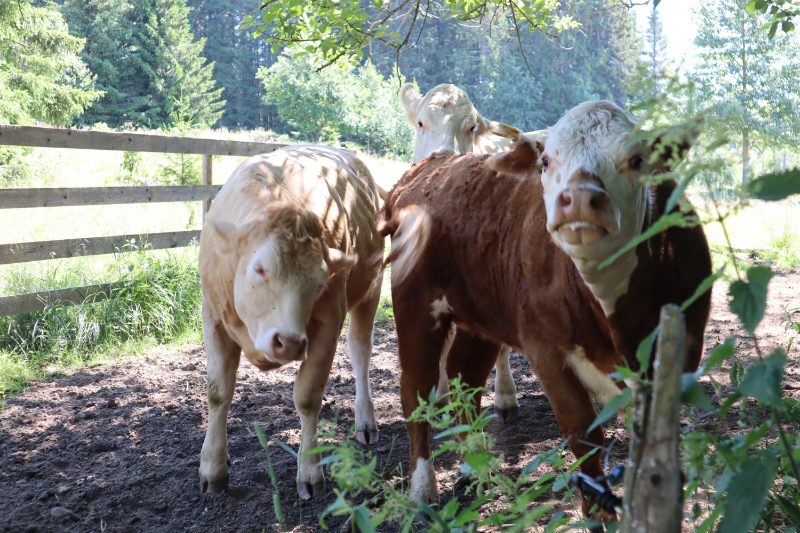
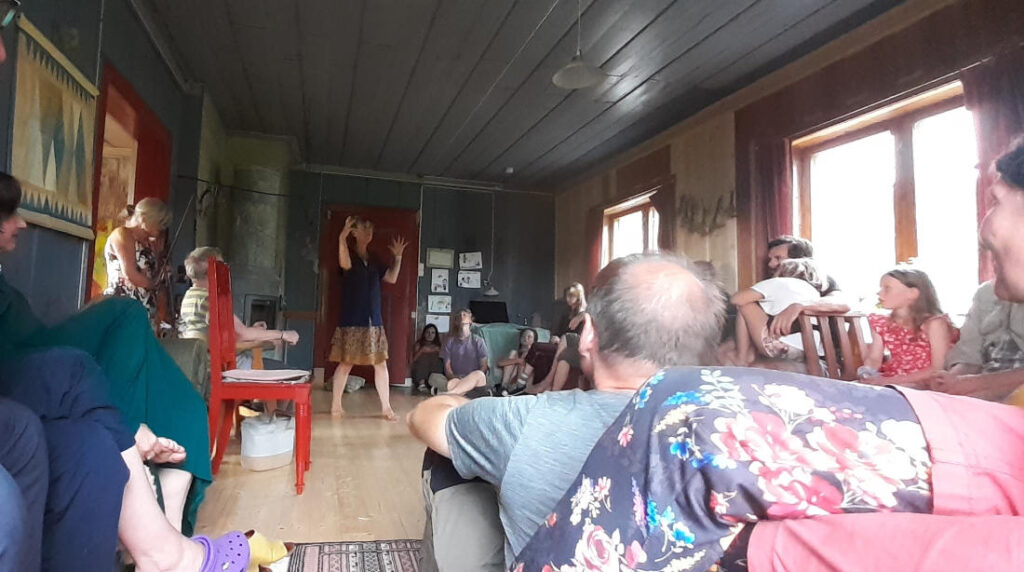
At Opsal farm, we use stories to get to know the animals, the birds, the forest and all the others that live here, including Huldra. Children and adults enjoy the stories together and we realize that it is not just people who live here now.
Buildings at Opsal Farm
In the storage barn (Stabbur) from around 1790, there are still signs of a truly self-sufficient life. Here you can find your tools, and wander out into forest or field to meet some of the farm’s non-human inhabitants.
During the spring of 2021, the ‘Stabbur’, which is a traditional building you will find on almost all Norwegian farms was refurbished! With support from Kulturminnefondet.
See the pictures here.


This house is called the Føderådet, the house traditionally for the elderly on the farm. There is even a special ‘coffin door’ only used when your body leaves the house for the last time.
For those who take courses over several days, this is the place where you experience what it was like to live without electricity and water. Light glows from oil lamps and water is fetched from the well. Some people might have to watch their heads and bend to get through the doors, as the ceilings are seriously low.
The living room is used for storytelling gatherings in the evening, and participants are welcomed to tell stories. You might hear about the respect and contact many had with animals only a short time ago, and how unbelievably tough life was for many.
The aim is that we feel inspired to act as a key-stone species, as so many of our ancestors have done for millennia.
This outhouse
could do with some
TLC
– tender loving care!
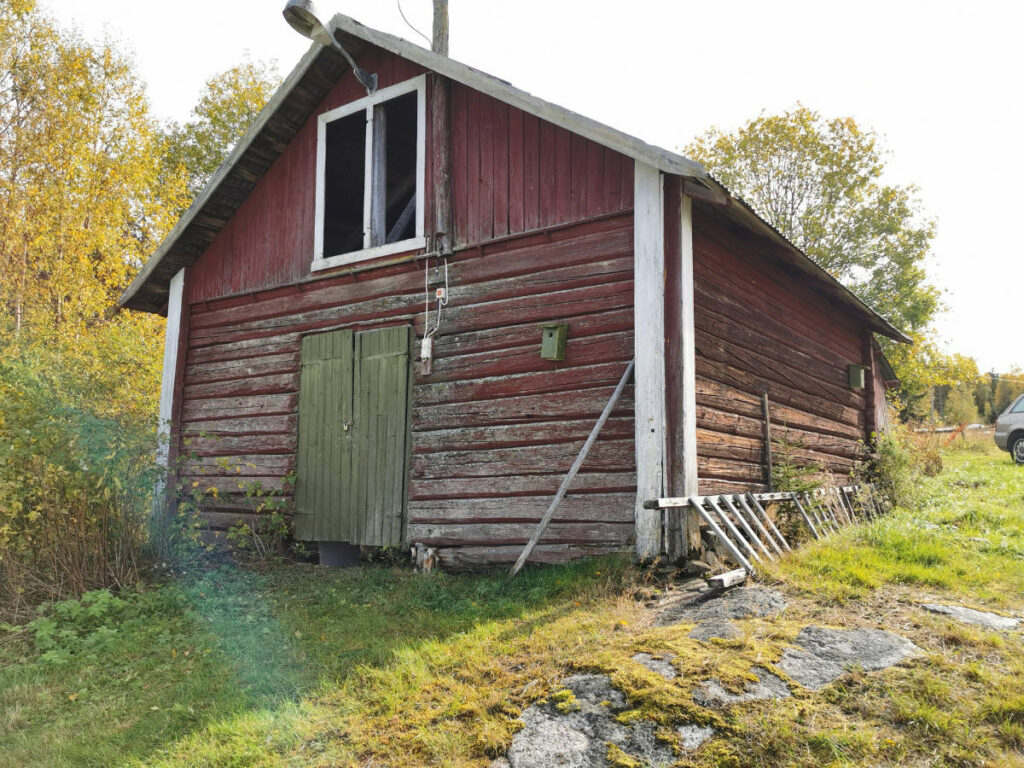
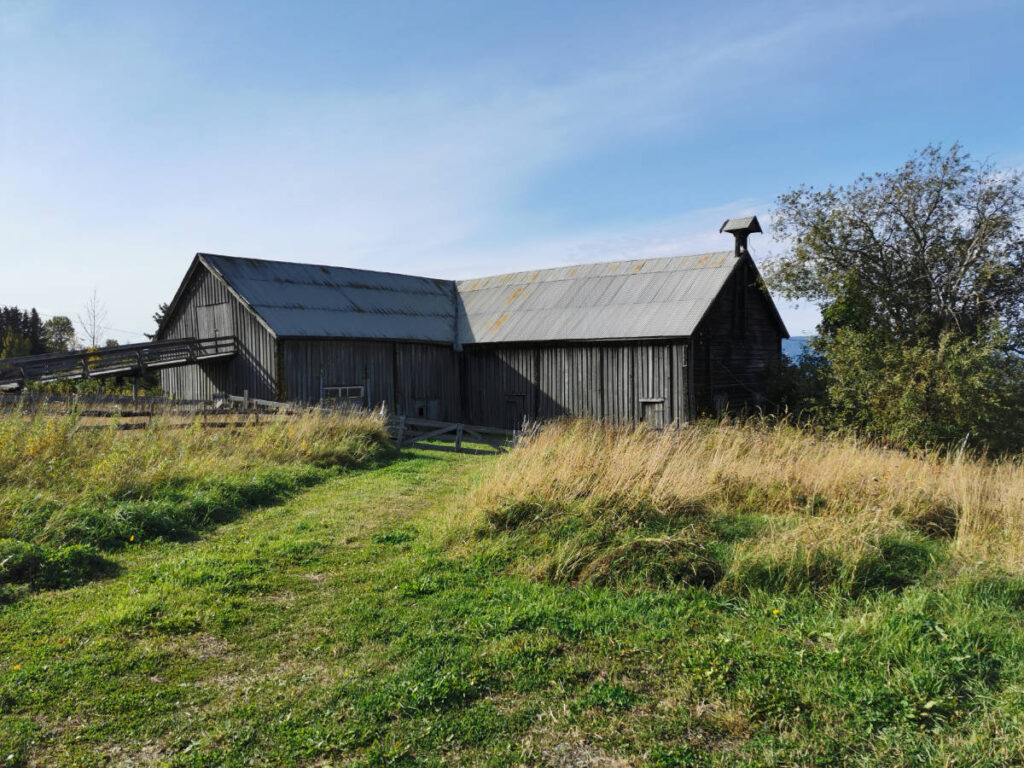
This barn is over 200 years old, its quite a unique building. Before it would have housed many animals, today the neighbour’s cows enjoy the fine pastures.
The existing farm buildings play an important role in the visitor’s experience. Instead of modern houses or ordinary cement farm buildings, we gather in the old farmhouse for workshops, food and socializing.
Here, the atmosphere is slower, perhaps quieter, in the winter, darker. Your body may be buzzing after physical participation. You may be inspired to action or deeper reflection.
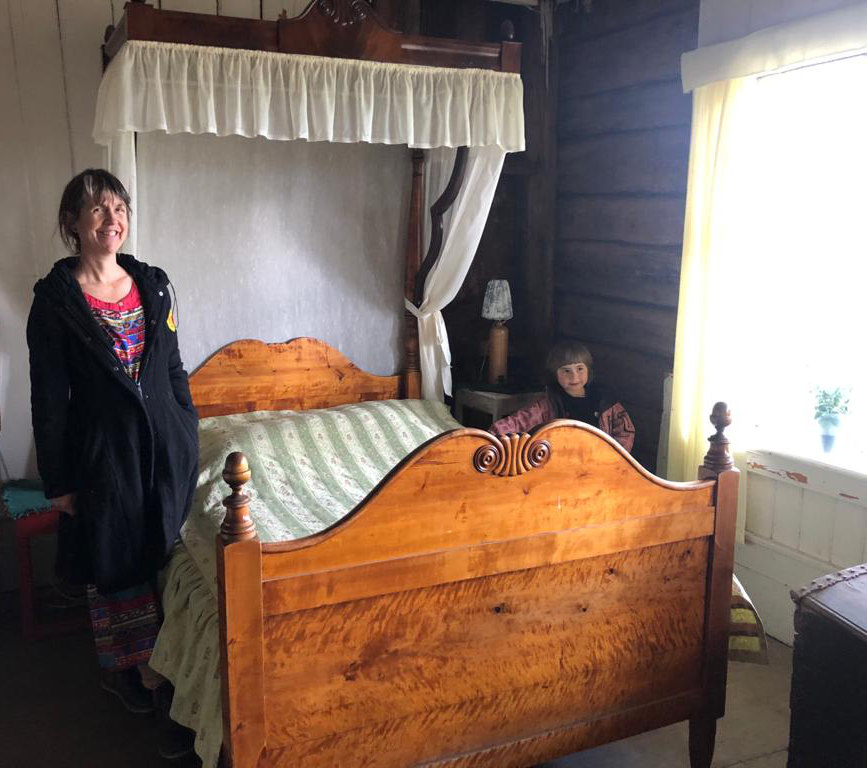
Biodiversity
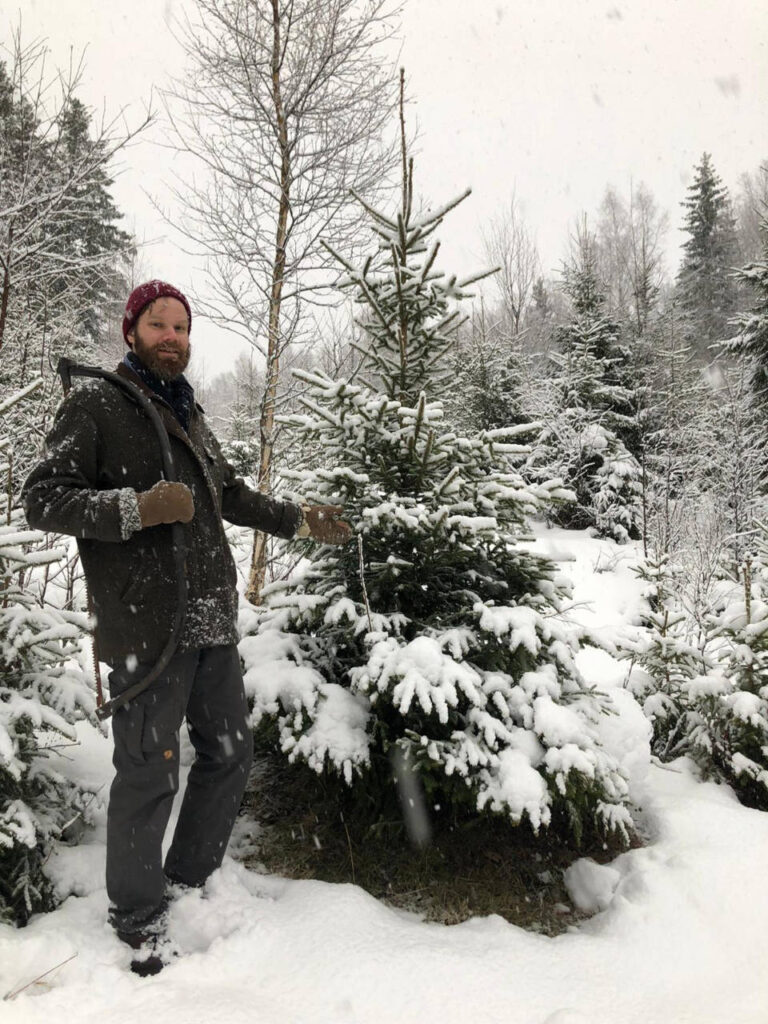
Modern production methods and lifestyles today constitute the greatest threat to biodiversity.
Demolition and change of land use are covering ever more earth and living nature below concrete and asphalt. Nature is being destroyed by a perpetual increase in transport and traffic. Modern agriculture has been made possible through access to cheap fossil energy and the mechanization. The consequences have been major depletion of the soil and massively reduced diversity in agricultural areas.
At the same time, agriculture is also contributing to climate change, which poses a further threat to biodiversity.
At Opsal we want to provide a holistic experience that includes a sense of the connection between production and nature. Just 100 years ago, before industrial agriculture based on fossil energy sources and extensive use of machinery made its full entry into Norway, the natural diversity in and around Norwegian farms was completely different. There were more animals, more plant diversity, but also – perhaps a little annoying for modern humans – more insects 🙂
The pastures here are grazed as they have been for many decades. Areas which formerly were used for grain are now also pasture, and other parts of the pastureland are returning to forest. The pasture is filled with lush wildflowers which in turn leads to a rich insect life and many birds thrive here.
However in the area of cultivated land where artificial fertiliser has been used in recent years there has not been a single flower to be seen. This is changing now and a larg area is now devoted to meadow. This habitat is the most species-rich type of agricultural land in Norway and will often contain the rarest species. It has been said that ‘the meadows are the stave churches of the cultural landscape’. We want to establish a yearly mowing tradition that takes place from the end of July with scythe, raking, fiddle playing and dancing!
We are also composing a herbarium, a physical book with an example of each flower and plant we find. This will form a baseline, to see where the farm is now, so we can see the development in years to come. We are also making a study of the forest, again to have some reference point for the work which nature (ourselves included) is busy with…
WWOOFING – Volunteering on Opsal Gard
If you would like to volunteer you will of course get your (mainly organic vegetarian) meals and stay on the farm if you are not local. You can contact us direct or if you want to stay for a longer period then sign up to the Wwoofers organisation (for free:).
A bit about our farm in English –
This is a new project on a very old farm. We are talking about a pioneering project! The focus is rewilding and biodiversity. While we are also wanting to grow our own food, the well-being of the forest and other wild and domestic creatures is also super important.
The activities will vary a lot! We will be moving the cows, making fences and compost, planting trees and wooding for next winter, harvesting herbs berries and vegetables. We are planning a walled garden, a forest garden with ‘fedges’, a mix of a hedge and a fence, and we will be organically restoring the house and barn..
This year we have a range of courses which include herbal walks, organic building, storytelling in nature, seed sharing, carbon capture in regenerative agriculture and introduction to Permaculture. If you come to live on the farm you are welcome to join the courses. We would like you to be a creative part of the development of the farm but you will also need to help with the practical running of courses and welcoming guests.
No-one has been living full time on this farm for 50 years, so things are very basic. The buildings are 200 years old and very cute and old-fashioned. There is electricity and internet but heating is by wood stoves and cooking on gas. There is an outside toilet and right now the water comes from the well but we hope that by the time you arrive we have a washing machine.
We will be looking at the corona situation and up-dating the courses according to the local health advice. As most of the courses will take place outside we hope to be able to manage, but if its not possible within the regulations then of course we will cancel.
Local area: We are 10 minutes drive from the station and the shop, which is 1 hour from Oslo. It’s a very friendly neighbourhood with quite a lot of artistsW, and people pop by for a chat which is not so usual in Norway!
Accommodation: You will have your own bedroom and we will share kitchen and food-making. I work as The Natural Storyteller, so some of the time I will be away during the day and you will need to be able to manage your own time. I have three grown up children who work with herbs, theatre and sustainable transport. They will be visiting with their children, and there will be plenty of social interaction which you are free to join if you wish. There is a group of people who are supporting the farm who will also be living here and helping at times.
We will also invite groups like Extinction Rebellion, the Permaculture organisation and some other spiritual groups to come and use the farm as inspiration and a place to work.